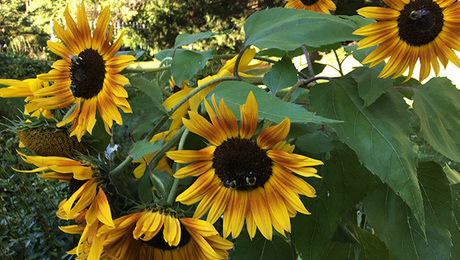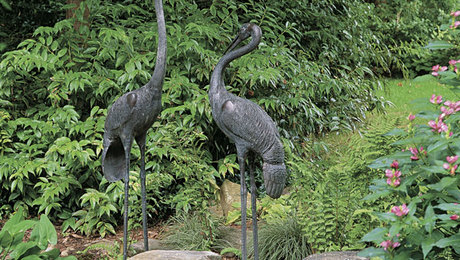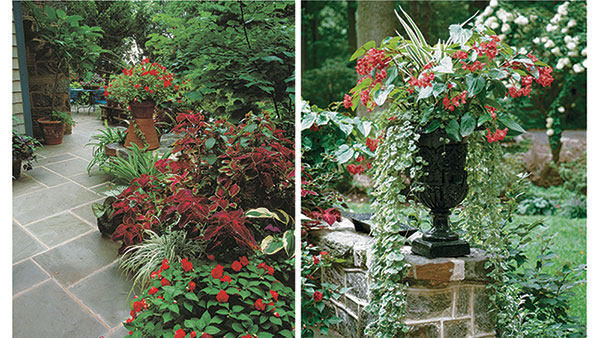
In recent summers, the north-facing terrace that wraps around the back of our old farmhouse has looked like an in-ground garden. But the plants there are all in containers. This movable, different-every-year garden gives me enormous pleasure for minimum labor. It is a place where I try risky color schemes and experiment with unusual annuals and tender perennials. It is a place where I practice garden design without having to dig. In short, it’s a place where I can have my cake and eat it, too.
An ugly terrace becomes a potted garden
While I have always enjoyed assembling plant combinations in containers, making the whole terrace into a garden with structure and focal points is a relatively new venture. It all began when we gave up trying to make the 12-foot-wide, 33-foot-long slab of cement we inherited with the house into an outdoor living space.
Years ago, we tried to relieve the ugliness of the cement by adding a low brick wall. While the soft, warm color of the old bricks took the curse off the cement, the enclosed space was even less congenial. The terrace was just too narrow for a comfortable grouping of garden furniture. It was also too hot in the summer. From June to August, it bakes in the sun for eight hours a day.
Ironically, everything that was wrong from a human perspective proved right for potted plants. My geraniums loved the heat and the sun. The cucumbers in containers grew like weeds, their trailing vines cascading down the sides of the half whiskey barrels and creeping along the paved surface. Soon, the low walls were given over to pots of rosemary, barrels of patio tomatoes, and window boxes of petunias and nasturtiums.
Eventually, the plants won. We gave up trying to sit on the terrace and fled to the friendly shade of an old apple tree. There, we could lunch in comfort and arrange the garden furniture in companionable groupings.
Grouping pots gives shape to the space

From a practical standpoint, the terrace serves as an entrance into the main garden from the sliding glass doors in the kitchen. Opposite the 6-foot-wide doors, a comparable opening in the low brick wall leads onto the lawn, providing a view down the long axis of the garden. An axis is just an imaginary straight line, a spine along which elements of a garden can be arranged. I understood this concept in the larger landscape, and found that an axial arrangement on the terrace proved valuable, too.
To make the boxcar-shaped terrace more interesting, it needed to be divided. It made sense to imagine a linear axis running from the entrance at the narrow end to the middle of the wall at the far end (photo, right). One year, I used an Australian rosemary (Westringia fruticosa, also known as W. rosmariniformis) standard set on the wall for a focal point. The wall gave the potted plant added height and importance.
From the start, I had been putting pots of geraniums (Pelargonium spp.) on either side of the wide opening in the low brick wall between the terrace and the garden. But I soon realized that to hold their own with the view, the containers themselves needed to be bigger. So I bought two pots 20 inches high and 24 inches across. At first, I clung to my early planting scheme of red geraniums surrounding tall, spiky dracaenas (Dracaena marginata), with Vinca major draped over the edges of the containers. Later, I made more adventurous choices, such as cannas (Canna cvs.), coleus (Solenostemon scutellarioides cvs.), and bronze fennel (Foeniculum vulgare ‘Purpureum’).
There are two other openings in the perimeter of the brick wall. One at the narrow end links the terrace to the breezeway. This is the approach to the garden that visitors use. A second opening at the far end of the terrace provides access to the dog run. Both entrances are vital. The first needed emphasis to announce its function and appear welcoming; the second needed to be disguised.
Disguise an eyesore with a vine-laden arbor

Emphasizing the visitor’s entrance with larger pots and groupings of smaller pots was relatively easy. The dog run, however, required a different technique. Instead of drawing attention to the opening, I wanted to hide it. So I built an arbor out of maple saplings and grew annual vines on it. The gate to the run was still accessible through a swinging curtain of tendrils, leaves, and flowers, but it didn’t advertise itself. To obscure an eyesore, vines have to be vigorous and leafy. My favorites for this purpose are scarlet runner bean (Phaseolus coccineus), moonflower vine (Ipomoea alba), and ‘Heavenly Blue’ morning glories (Ipomoea tricolor ‘Heavenly Blue’).
As more and more plants and pots accumulated on the terrace, I began massing them at the feet of the entrance plants and in groups on either side of the imaginary axis. By the end of the season, only a path from one end of the terrace to the other remained between sprawling nasturtiums (Tropaeolum majus) and sweet potato vines (Ipomoea batatas). What started out as a miscellaneous collection of potted plants has evolved into a real garden.
Then I found a cedar arch that fit exactly into the narrow opening in the brick wall where visitors enter. Finally, the terrace garden was complete. It was amazing what this simple structure accomplished. Although the lattice sides were light and open, they hid part of the terrace so that visitors didn’t know quite what to expect. What had been an exposed, open space, now seemed a private, almost secret enclosure. Growing a dainty but lusty clematis (Clematis tangutica) in pots on either side of the arch provided the finishing touch.
Add focal points to strengthen the design


The arch also introduced a slightly formal element and seemed to call for a different treatment of the space it framed. I was reminded of a design principle I learned from my gardening friend Peter Wooster. He describes the technique as “addressing the corners.”
The rectilinear beds in Peter’s garden explode with myriad textures, shapes, colors, heights, and plant forms, but the excess is subtly contained. Each bed is given structure by emphatic plants in the corners and centers. These emphatic plants may be evergreens or deciduous shrubs, and they serve as brackets, defining the corners and holding the gardens within their embrace.
To draw attention to the corners of the terrace, I needed something manmade to reinforce the sense of formality and enclosure. A graceful 6-foot trellis made of twisted grapevines did the trick in one corner, while a fountain did the same in the other.
The fountain, my pride and joy, is the joint effort of our friend, Elizabeth McDonnell, a ceramic artist, and Trevor Youngberg, a potter. A little jet of water shoots upward from the beautiful ceramic ball Elizabeth made and subsides into Trevor’s shallow bowl, supported on a matching pedestal (photo below left). The blue-green glaze and the elegant relationship between the ball and the saucer immediately draw the eye as you enter the terrace garden, and the sound of the water is alluring.
The fountain’s location is just right, though it was much debated. I carried it tenderly from corner to corner trying it in different positions. I tried it in the middle of a long stretch of wall on one side of the main opening, but felt it was wasted there. The entrance corner won out. And that’s just one advantage of a terrace garden: structural features and focal points can be small and portable, like the fountain. They can be moved around until they are in the right place.
At the far end of the terrace, opposite and centered on the arch, is a wroughtiron table. Secondhand and rather worse for wear, the table is still graceful and serves as a stand for my best pot, another focal point in the potted garden. This treasure is a blue ceramic bowl 9 inches deep that rises from an 11-inch base and flares to 18 inches across. Last year, I planted it with red geraniums, glowing spikes of salmonpink and olive-green New Zealand flax (Phormium tenax), a peach-colored salvia (Salvia splendens ‘Carabiniere Orange’), and a wonderful coleus with pink patterns on the cocoa-brown leaves (photo above right).
Maintaining a potted garden

While a potted garden is physically undemanding, it does require vigilance. Since the garden is small and the plants are viewed at close range, grooming is critical. Regular removal of dead flowers from annuals not only makes them look better, it also keeps them flowering. Don’t hesitate to cut back foliage plants whose branches get too long and ungainly. Take scissors or clippers and cut the stems back to a pair of leaves.
Watering is the trickiest chore because it is weather dependent. The hotter the temperature, the more often you have to water. The rate of evaporation also depends on the pot. A big container retains moisture longer than a small one. Also, plastic pots hold moisture longer than porous clay and wooden containers.
I water my pots almost every day from June to September. As the weather gets cooler and the nights shorter, I water less often. Always soak the soil thoroughly. Water should run out of the drainage holes. Then, allow the plants to use up that water before you add more.
Watering and fertilizing can be done together. Every week or two during the height of the season, I dissolve a balanced fertilizer in the watering can and apply it to all the potted plants. I fertilize less frequently from September on.
As the gardening season winds down, I move some plants indoors for the winter, like the Australian rosemary, and I take cuttings of others like my beloved Brugmansia. Eventually, Jack Frost gets the rest. Plant remains go to the compost pile and I use the spent soil to fill holes in the lawn. I store my pots in a shed for the winter, except for the large wood and plastic planters, which can stand the rigors of the season. I remove half of the soil from these, and replenish it in the spring.
Experiment with color, shape, and new plants

I love color. Until I had a garden, I had to make do with paints—watercolors and oils—but nothing has given me as much pleasure as arranging and rearranging leaf and flower colors—colors the Winsor Newton Company never dreamed of. Putting together a cohesive, large-scale color scheme in the garden requires time and considerable horticultural expertise. But putting colors together in containers is easy.
You can afford to try wild associations, such as magenta petunias (Petunia cvs.) with Mexican flame vine (Senecio confusus). In an in-ground border, the pleasurable shock of orange and magenta might pall, but in a container, I find it exciting. I love experimenting with jarring contrasts on the one hand (photo, at right) and graduated color harmonies on the other. A successful combination in pots may give you ideas for your in-ground garden. An unsuccessful scheme is easily remedied: move the pots or pull out the offending plant.
Making a garden on your terrace can be a dress rehearsal for in-ground gardening or an end in itself. For the past three summers, I have worked on the garden-within-a-garden theme: trying different color schemes and experimenting with new plants. What is fun is the flexibility and freedom it gives me.
Every summer, layers of planting rise from the paving on my terrace garden. The trailing plants grow into each other and form ground covers, while the taller, bushier plants, like geraniums, coleus, and New Guinea impatiens fill the mid-border positions. The cannas seem to reach as tall as the soaring stands of Joe Pye weed (Eupatorium fistulosum ‘Gateway’) in the perennial border.
I even have trees in the garden-withina- garden. The angels’ trumpets (Brugmansia ‘Charles Grimaldi’), grown each year from cuttings, shoot up to 6 feet during the season, and by August, they shade the potted plants at their feet. The effect of the total garden surprises and delights me.
Imagine a garden where you can divide the space in a different way every year. By arranging pots in groups, curves, or straight lines, you can make hedges and lay out paths. You can create flower beds by planting trailing plants as ground covers in the same pots with large plants, and by staggering the sizes of your pots.
Think of your potted garden as if it were an in-ground border. You want edging plants and background plants; you want different heights and sizes; you want an interesting horizon with ups and downs; and you want contrasts in shapes of flowers and foliage. You can tinker with your potted border all summer. If a plant gets too big for its allotted space, move it. Instead of a backbreaking hour, it will take you a couple of minutes.
Big pots have to remain in place once planted, but the smaller pots can be shuffled around to your heart’s content. If you decide in the middle of the summer that you want something different, add or subtract a few containers.
Single plants in pots are a useful learning device because they can be popped in and out of arrangements, and recombined in different ways. Large containers using several different kinds of plants are more of a challenge, but that’s part of the fun. As a rule, even a large container, such as a half whiskey barrel, looks better when the variety of plants is limited to three or four kinds, plus a trailer to drape over the edge.
But rules are made to be broken. The real joy of making a garden with potted plants is that you actually can have it all. You can take risks and get away with it. You can go overboard without going bankrupt. You can have a beautiful garden without killing yourself with work. It’s a win-win situation.

















Comments
my Aunty
Allison recently got a nice 6 month old Jaguar by working from a macbook.this website Cashduties.COM
Wow! That's a pretty impressive garden from pots. Especially impressive are the Angel's Trumpets, blooming away, completely oblivious to their reputation for not doing well in a pot. Everything looks so lush and healthy.
Log in or create an account to post a comment.
Sign up Log in